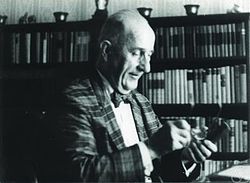Carl Ludwig Siegel
Appearance

Carl Ludwig Siegel (31 December 1896 – 4 April 1981) was a German mathematician who won the Wolf Prize in Mathematics in 1978.
| This article about a mathematician is a stub. You can help out with Wikiquote by expanding it! |
Quotes
[edit]- Let θ be an algebraic integer and assume that all conjugates of θ, except θ itself, have an absolute value less than 1. Then –θ also has this property; on the other hand, θ is real. Without loss of generality, we may therefore suppose θ ≥ 0. Since the norm of θ is a rational integer, we have θ ≥ 1, except for the trivial case θ = 0. Recently, R. Salem ... discovered the interesting theorem that the set S of all θ is closed and that θ = 1 is an isolated point of S. Consequently there exists a smallest θ = θ1 > 1. We shall prove that θ1 is the positive zero of x3 – x – 1 and that also θ1 is isolated in S. Moreover we shall prove that the next number of S, namely the smallest θ = θ2 > θ1, is the positive zero of x4 – x3 – 1 and that θ2 is again an isolated point of S. Since θ1 = 1.324..., θ2 = 1.380..., both numbers are less than 2½; therefore our statements are contained in the following:
Theorem. Let θ be an algebraic integer whose conjugates lie in the interior of the unit circle; if ±θ ≠ 0, 1, θ1, θ2, then θ2 > 2.- (1944). "Algebraic integers whose conjugates lie in the unit circle". Duke Mathematical Journal 11 (3): 597–602. DOI:10.1215/S0012-7094-44-01152-X.
- I am afraid that mathematics will perish by the end of this century if the present trend for senseless abstraction — as I call it: theory of the empty set — cannot be blocked up.
- in a 1964 letter to L. J. Mordell as quoted by C. S. Yogananda (June 2015). "The Life and Times of Bourbaki". Resonance: 556–559. (quote from p. 558)
- Ours, according to Leibnitz, is the best of all possible worlds, and the laws of nature can therefore be described in terms of extremal principles. Thus, arising from corresponding variational problems, the differential equations of mechanics have invariance properties relative to certain groups of coordinate transformations.
- Lectures on Celestial Mechanics. 2012. p. 1; reprint of 1971 1st edition
- The theory of functions of several variables turns out to be essentially more difficult than the theory of one variable because of the existence of points of indeterminacy. In the case n > 1, a mere glance at the poles already indicates a behavior which is completely different from that in the case n = 1. The reason is that, in case n > 1, the poles are not isolated and, in general, there does not exist a Laurent expansion. In a neighborhood of a nonregular point we are forced to view meromorphic functions as quotients of power series.
- Topics in Complex Function Theory, Volume 3: Abelian Functions and Modular Functions of Several Variables. 1989. p. 23. ISBN 9780471504016; 1973 1st edition
- One of the many importants ideas introduced by Minkowski into the study of convex bodies was that of gauge function. Roughly, the gauge function is the equation of a convex body. Minkowski showed that the gauge function could be defined in a purely geometric way and that it must have certain properties analogous to those possessed by the distance of a point from the origin. He also showed that conversely given any function possessing these properties, there exists a convex body with the given function as its gauge function.
- Lectures on the Geometry of Numbers. 2013. p. 6; 1989 1st edition
- Ein Bourgeois, wer noch Algebra treibt! Es lebe die unbeschrankte Individualitat der transzendenten Zahlen! ["It's a bourgeois, who still does algebra! Long live the unrestricted individuality of transcendental numbers!"]
- Found in his manuscript for Transcendental numbers (1950), quoted in André Weil, The Apprenticeship of a Mathematician (1992), p. 53,
Quotes about Siegel
[edit]- ... Siegel kept working well into his eighties, after he had returned to Göttingen.
- Atle Selberg, as quoted by Betsy Devine, Interview with Atle Selberg, conducted at his office in Fuld Hall, Institute for Advanced Study. publications.ias.edu (June 15, 1989). (quote from p. 14)
- ... when Carl Ludwig Siegel announced that he would hold class on a University holiday, his students left the room empty on the appointed day, hiding nearby to see what he did. “Sure enough, Siegel got up front in the empty room, started in with the beautiful lecture as though he had a full room,” said Merrill Flood *35. After he had continued for a while, “we sheepishly trooped in, and listened to his lecture.”
- Elyse Graham, (January 10, 2018)"Adventures in Fine Hall". Princeton Alumni Weekly.
- In 1966 Siegel oversaw the publication of his collected works in three volumes. He spent the rest of his life editing (and writing) a fourth volume. As the story goes, he burned everything else, fearing that a historian—as he himself had done with Riemann—would get into his papers.

